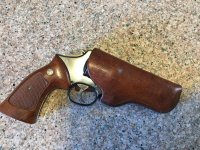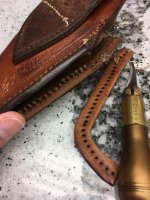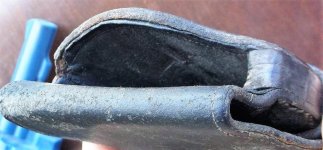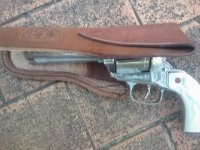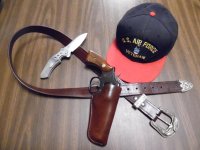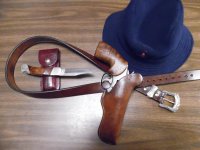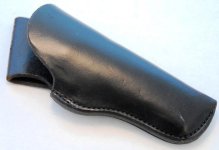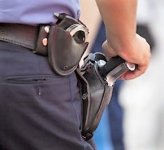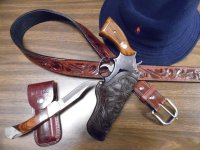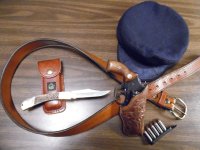OP
rednichols
Member
- Joined
- Jul 24, 2012
- Messages
- 2,745
- Reaction score
- 8,503
I always thought of the Threepersons as a holster for a single action. Not that it can't be used for other actions, but given the SA as a starting point the relevant criteria for me is the exposed trigger guard, exposed hammer, forward cant and a high-ride.
The Wolfram pictured would not qualify as the hammer has too much coverage. I picture a Threepersons as exposing a great deal of the revolver at the top.
My hands-down favorite would be the Lawrence 120. The Myers is right there with it.
Oooh, kinda right. The Threepersons is indeed always described that way, beginning with his shooting buddy Charlie Askins. But it's not a correct definition; but rather an unintended result.
Follow me: the first 'threepersons' was developed from the basic holster design of Texas' famous King Ranch, which was trimmed to a minimum and raised high on the belt and tilted with the rear sight ahead of the front sight; called 'positive caster'.
 Notice the large 'cuff', the large belt loop tunnel, the wide fender behind the holster body, the very long drop. It's not yet a Threepersons: to big, too wide, too deep.
Notice the large 'cuff', the large belt loop tunnel, the wide fender behind the holster body, the very long drop. It's not yet a Threepersons: to big, too wide, too deep.The result of all that trimming was what we know today as a Brill although August Brill did not create it.
This was done so that the Texas Rangers assigned to Austin in 1906ish could fully conceal all of their arms and ammo. The result was the exposed trigger guard because the pistol grip was above the belt line; and that belt was only a 1" wide trousers belt now; no gunbelts allowed and certainly no ammo on the trousers belt.
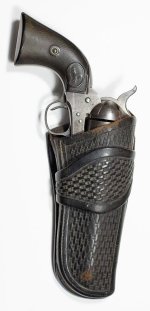 This one is from Brill's earliest period. A second Brill era began in 1932 and they are distinctly different. Now notice all the leather that's been cut away, and that the revolver will ride very high and angled.
This one is from Brill's earliest period. A second Brill era began in 1932 and they are distinctly different. Now notice all the leather that's been cut away, and that the revolver will ride very high and angled.When Tom Threepersons' maker, believed to be in Douglas AZ, got done with it the difficult cuff and fender were gone, too; and it looked like this (this is actually Tom's prototype):

He licensed Sam Myres to use his name -- i.e., he 'endorsed' the new gunleather range of 1930 -- and when that appeared it looked like this:

And by the time it got to become FBI issue, and used by the likes of D.A. Bryce and Jerry Campbell, it looked like this:

Gunleather makers have been copying that last design ever since; including Lawrence.
What IS a Threepersons: for a revolver it has a mighty thick welt inside that grips the frame. For an automatic the welt is there, too, but the guard is INSIDE the holster still. It is MOST common for the DA yet that very short frame ahead of the guard makes it problematic to actually grip much; and by this century every gunleather maker including EPS had forgotten the purpose of the welts so rarely are they functional except by accident of construction.
Last edited:









